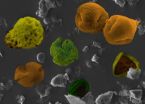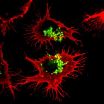(Press-News.org) Researchers in France have uncovered a mechanism which explains how biological clocks accurately synchronize to the day/night cycle despite large fluctuations in light intensity during the day and from day to day. Following the identification of two central "clock genes" of a green alga, Ostreococcus tauri, a mathematical model reproducing their daily activity profiles has revealed that their internal clock is influenced by the naturally varying light levels throughout the day only at periods when it needs resetting. The results found by the biologists at Oceanologic Observatory of Université Paris 6 in Banyuls, France, physicists at Université Lille 1, France, together with the Centre National de la Recherche Scientifique, are published November 11 in the open-access journal PLoS Computational Biology,
Circadian clocks keep track of time in many living organisms, allowing them to anticipate environmental changes induced by day/night alternation. They consist of networks of genes and proteins which interact to generate biochemical oscillations with a period close to 24 hours. Exact synchronization to the day/night cycle requires that some clock components sense daylight. Ostreococcus has evolved a simple but effective strategy to shield the circadian clock from interference caused by fluctuations in the levels of daylight by limiting sensitivity to light to specific times of day. In the authors' model, as in experiments, this ability is furthermore inactivated when the clock is in phase with the day/night cycle but resets the clock when it is out of phase. Such a clock architecture is immune to strong daylight fluctuation such as due to cloud cover.
Light sensing is assumed to be activated only when the core oscillator controlling the biological clock is blind to perturbations and variations. As anyone who has pushed a swing knows, the response of a periodic motion to a perturbation depends indeed very much on the timing; pushing a swing mid-arc doesn't achieve much. With this simple trick, the clock is insensitive to light and its fluctuations when it is on time. However, if the clock becomes out of phase, it will be subjected to light at a different time of its cycle, and respond to the perturbation so as to be reset to the correct time.
INFORMATION:
Funding: This work has been supported by ANR grant 07BSYS004 to F.-Y.B. and M.L., by CNRS interdisciplinary programme "Interface Physique, Biologie et Chimie : soutien à la prise de risque" to M.L., as well as by Ministry of Higher Education and Research, Nord-Pas de Calais Regional Council and FEDER through the Contrat de Projets État-Région (CPER) 2007-2013. The funders had no role in study design, data collection and analysis, decision to publish, or preparation of the manuscript.
Competing Interests: The authors have declared that no competing interests exist.
Citation: Thommen Q, Pfeuty B, Morant P-E, Corellou F, Bouget F-Y, et al. (2010) Robustness of Circadian Clocks to Daylight Fluctuations: Hints from the Picoeucaryote Ostreococcus tauri. PLoS Comput Biol 6(11): e1000990. doi:10.1371/journal.pcbi.1000990
PLEASE ADD THIS LINK TO THE PUBLISHED ARTICLE IN ONLINE VERSIONS OF YOUR REPORT: http://www.ploscompbiol.org/doi/pcbi.1000990 (link will go live on Thursday)
PRESS-ONLY PREVIEW OF THE ARTICLE: http://www.plos.org/press/plcb-06-11-Lefranc.pdf
Everything published by PLoS Computational Biology is open access, allowing anyone to download, reuse, reprint, modify, distribute, and/or copy articles, so long as the original authors and source are cited. Please mention PLoS Computational Biology in your report and use the link(s) below to take readers straight to the online articles. Thank you.
About PLoS Computational Biology
PLoS Computational Biology (www.ploscompbiol.org) features works of exceptional significance that further our understanding of living systems at all scales through the application of computational methods. All works published in PLoS Computational Biology are open access. Everything is immediately available subject only to the condition that the original authorship and source are properly attributed. Copyright is retained.
Keeping the daily clock ticking in a fluctuating environment: Hints from a green alga
2010-11-12
ELSE PRESS RELEASES FROM THIS DATE:
Cats show perfect balance even in their lapping
2010-11-12
CAMBRIDGE, Mass. — Cat fanciers everywhere appreciate the gravity-defying grace and exquisite balance of their feline friends. But do they know those traits extend even to the way cats lap milk?
Researchers at MIT, Virginia Tech and Princeton University analyzed the way domestic and big cats lap and found that felines of all sizes take advantage of a perfect balance between two physical forces. The results will be published in the November 11 online issue of the journal Science.
It was known that when they lap, cats extend their tongues straight down toward the bowl ...
New explanation for the origin of high species diversity
2010-11-12
PHILADELPHIA—An international team of scientists, including a leading evolutionary biologist from the Academy of Natural Sciences, have reset the agenda for future research in the highly diverse Amazon region by showing that the extraordinary diversity found there is much older than generally thought.
The findings from this study, which draws on research by the Academy's Dr. John Lundberg and other scientists, were published as a review article in this week's edition of Science. The study shows that Amazonian diversity has evolved as by-product of the Andean mountain ...
Tropical forest diversity increased during ancient global warming event
2010-11-12
The steamiest places on the planet are getting warmer. Conservative estimates suggest that tropical areas can expect temperature increases of 3 degrees Celsius by the end of this century. Does global warming spell doom for rainforests? Maybe not. Carlos Jaramillo, staff scientist at the Smithsonian Tropical Research Institute, and colleagues report in the journal Science that nearly 60 million years ago rainforests prospered at temperatures that were 3-5 degrees higher and at atmospheric carbon dioxide levels 2.5 times today's levels.
"We're going to have a novel climate ...
Study finds the mind is a frequent, but not happy, wanderer
2010-11-12
CAMBRIDGE, Mass. -- People spend 46.9 percent of their waking hours thinking about something other than what they're doing, and this mind-wandering typically makes them unhappy. So says a study that used an iPhone web app to gather 250,000 data points on subjects' thoughts, feelings, and actions as they went about their lives.
The research, by psychologists Matthew A. Killingsworth and Daniel T. Gilbert of Harvard University, is described this week in the journal Science.
"A human mind is a wandering mind, and a wandering mind is an unhappy mind," Killingsworth and ...
Voluntary cooperation and monitoring lead to success
2010-11-12
FRANKFURT. Many imminent problems facing the world today, such as deforestation, overfishing, or climate change, can be described as commons problems. The solution to these problems requires cooperation from hundreds and thousands of people. Such large scale cooperation, however, is plagued by the infamous cooperation dilemma. According to the standard prediction, in which each individual follows only his own interests, large-scale cooperation is impossible because free riders enjoy common benefits without bearing the cost of their provision. Yet, extensive field evidence ...
New vaccine hope in fight against pneumonia and meningitis
2010-11-12
A new breakthrough in the fight against pneumonia, meningitis and septicaemia has been announced today by scientists in Dublin and Leicester.
The discovery will lead to a dramatic shift in our understanding of how the body's immune system responds to infection caused by Streptococcus pneumoniae and pave the way for more effective vaccines.
The collaborative research, jointly led by Dr Ed Lavelle from Trinity College Dublin and Dr Aras Kadioglu from the University of Leicester, with Dr Edel McNeela of TCD as its lead author, has been published in the international peer-reviewed ...
Scientists demystify an enzyme responsible for drug and food metabolism
2010-11-12
For the first time, scientists have been able to "freeze in time" a mysterious process by which a critical enzyme metabolizes drugs and chemicals in food. By recreating this process in the lab, a team of researchers has solved a 40-year-old puzzle about changes in a family of enzymes produced by the liver that break down common drugs such as Tylenol, caffeine, and opiates, as well as nutrients in many foods. The breakthrough discovery may help future researchers develop a wide range of more efficient and less-expensive drugs, household products, and other chemicals. The ...
Gene discovery suggests way to engineer fast-growing plants
2010-11-12
DURHAM, N.C. – Tinkering with a single gene may give perennial grasses more robust roots and speed up the timeline for creating biofuels, according to researchers at the Duke Institute for Genome Sciences & Policy (IGSP).
Perennial grasses, including switchgrass and miscanthus, are important biofuels crops and can be harvested repeatedly, just like lawn grass, said Philip Benfey, director of the IGSP Center for Systems Biology. But before that can happen, the root system needs time to get established.
"These biofuel crops usually can't be harvested until the second ...
Stanford scientists identify key protein controlling blood vessel growth into brains of mice
2010-11-12
STANFORD, Calif. — One protein single-handedly controls the growth of blood vessels into the developing brains of mice embryos, according to researchers at the Stanford University School of Medicine. Understanding how the protein, a cellular receptor, functions could help clinicians battle brain tumors and stroke by choking off or supplementing vital blood-vessel development, and may enhance the delivery of drugs across the blood-brain barrier.
"The strength and specificity of this receptor's effects indicate that it could be a very important target," said Calvin Kuo, ...
Fortify HIT contracts with education and ethics to protect patient safety, say informatics experts
2010-11-12
Bethesda, MD—An original and progressive report on health information technology (HIT) vendors, their customers and patients, published online today, makes ground-breaking recommendations for new practices that target the reduction or elimination of tensions that currently mar relationships between many HIT vendors and their customers, specifically with regard to indemnity and error management of HIT systems. In light of the Obama Administration's $19 billion investment in HIT, paid out in ARRA stimulus funds, these recommendations are particularly significant in helping ...


